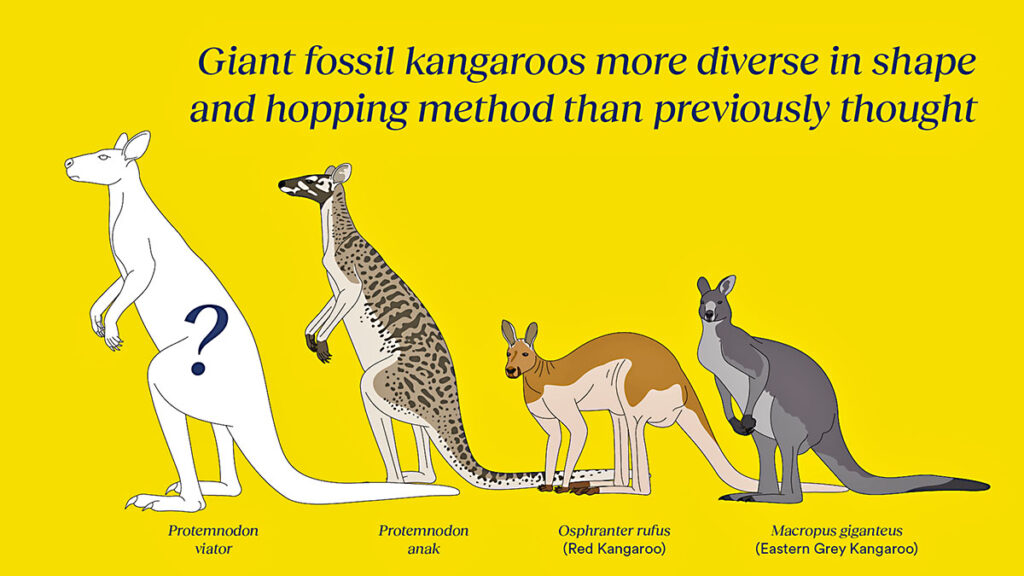Palaeontologists from Flinders University have described three unusual new species of giant fossil kangaroo from Australia and New Guinea, finding them more diverse in shape, range and hopping method than previously thought.
The three new species are of the extinct genus Protemnodon, which lived from around five million to 40,000 years ago – with one about double the size of the largest red kangaroo living today.
Some of the best fossils have been found in the Limestone Coast.
The research follows the discovery of multiple complete fossil kangaroo skeletons from Lake Callabonna in arid South Australia in 2013, 2018 and 2019.
These extraordinary fossils allowed lead researcher Dr Isaac Kerr, then a PhD student, to unpick a nearly 150-year-long puzzle around the identities of the species of Protemnodon.
The new Flinders University study reviewed all species of Protemnodon, finding they were quite different from one another.
The species adapted to live in differing environments and even hopped in different ways.
Protemnodon would have looked something like a grey kangaroo, but were generally more squat and muscular.
While some species were around 50kg, others were much larger than any living kangaroo.
However, one new species named as part of the latest study – named Protemnodon viator – was much bigger, weighing up to 170kg.
This is about twice as much as the largest male red kangaroos.
Protemnodon viator was well-adapted to its arid central Australian habitat, living in similar areas to the red kangaroos of today.
It was a long-limbed kangaroo that could hop fairly quickly and efficiently.
Its name, viator, is Latin for ‘traveller’ or ‘wayfarer’.
The Australian researchers discovered two other new species – Protemnodon mamkurra and Protemnodon dawsonae – while also revisiting the work of earlier researchers including British naturalist Sir Richard Owen who coined the term ‘dinosaur’ in Victorian England.
The first species of Protemnodon were described in 1874 by British palaeontologist Owen who followed the common approach of the time, to focus chiefly on fossil teeth.
He saw slight differences between the teeth of his specimens and described six species of Protemnodon.
Successive studies have whittled away at some of these early descriptions, however the new Flinders University study agrees with one of his species, Protemnodon anak.
This first specimen described, called the holotype, still resides in the Natural History Museum in London.
Dr Kerr said it previously was suggested that some or all Protemnodon were quadrupedal.
“However, our study suggests that this is true of only three or four species of Protemnodon, which may have moved something like a quokka or potoroo – that is bounding on four legs at times, and hopping on two legs at others,” he said.
“The newly described Protemnodon mamkurra is likely one of these.
“A large but thick-boned and robust kangaroo, it was probably fairly slow-moving and inefficient.
“It may have hopped only rarely, perhaps just when startled.”
Dr Kerr said the best fossils of this species came from Green Waterhole Cave in the South East, on the land of the Boandik people.
The species name, mamkurra, was chosen by Boandik elders and language experts in the Burrandies Corporation.
It means ‘great kangaroo’.

“It’s unusual to have a single genus of kangaroo live in such varied environments,” he said.
“For example, the different species of Protemnodon are now known to have inhabited a broad range of habitats, from arid central Australia into the high-rainfall, forested mountains of Tasmania and New Guinea.”
The third of the new species, Protemnodon dawsonae, is known from fewer fossils than the other two, and is more of a mystery.
It was most likely a mid-speed hopper, something like a swamp wallaby.
It was named in honour of the research work of Australian palaeontologist Dr Lyndall Dawson, who studied kangaroo systematics and the fossil material from ‘Big Sink’, the part of the Wellington Caves in NSW, from which the species is mostly known.
By about 40,000 years ago, all Protemnodon were extinct on mainland Australia, maybe lingering a while longer in New Guinea and Tasmania.
This extinction occurred despite their differences in size, adaptations, habitat and geographic range.
For reasons not yet clear the same did not happen to many similar and closely related animals, such as wallaroos and grey kangaroos.
This question may soon be answered by further research aided in some part by this study.




